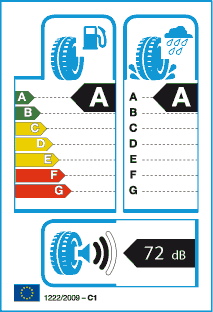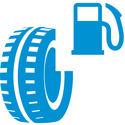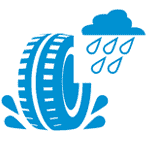EU Label information
The new EU tyre label is intended to give consumers more information when choosing new tyres.
The label shows wet grip (stopping distance in a straight line), exterior noise and fuel efficiency data. The presentation is based on the familiar EU energy efficiency label.

Note for car, 4x4 and van tyres:
Class D is not used so there are only 6 classes for Fuel efficiency. In addition, for Wet grip class G is also not used so there are only 5 classes for Wet grip.
Note for Avon Motorsport Tyres:
The supply of all Avon Motorsport road legal products is unaffected by the new legislation and will still be available through our dealer network.
This is because our tyres have either been tested and found to comply or, in the case of certain tyres, they are exempt from the legislation if fitted to vehicles registered for the first time before 1st October 1990. Tyres which have been tested will be appropriately labelled and exempt products will have a sticker with the following language “This tyre is designed to be fitted only to vehicles registered for the first time before 1st October 1990.” in relation to Regulation EC1222/2009.
The Avon Motorsport range of road legal tyres has the following grades or exemptions:
What does the label mean?
| FUEL EFFICIENCY (Rolling Resistance) Fuel efficiency is influenced by the tyre’s rolling resistance. Lower rolling resistance means lower fuel consumption and CO2 emissions. There is a 7.5% loss of fuel economy between the best and worst class (average). Note: fuel savings and road safety depend heavily on the behavior of drivers and eco‐driving can significantly reduce fuel consumption. |
| WET GRIP (Braking Performance) Wet grip is one of the most important performance characteristics in a tyre. The effect may vary among vehicles and driving conditions, but in the case of full braking, the difference between a G and an A class for a set of four identical tyres could be up to 30% shorter braking distance (e.g. for a typical passenger car driving at 80 km/h speed this could be up to 18m shorter braking distance). Note: stopping distances must always be respected. |
| NOISE (Exterior Rolling Noise – not cabin noise) Measured in decibels (dB)
|
What else is important when choosing new tyres?
The label does not address every factor which is critical to overall tire performance:
- Dry handling
- Dry grip (straight line)
- Dry grip (circles/cornering)
- Wet handling
- Wet grip (circles/cornering)
- Resistance to aquaplaning (straight/curved)
- High-speed stability
- Interior noise
- Tread wear
Please remember the following:
Actual fuel savings and road safety depend heavily on the behaviour of drivers:
- eco-driving can significantly reduce fuel consumption
- tyre pressures should be regularly checked to optimise wet grip and fuel efficiency performance
- stopping distances should always be strictly respected
Click here for further information on tyre labelling
For further information on the right choice of tyre for you, please consult your Avon stockist











